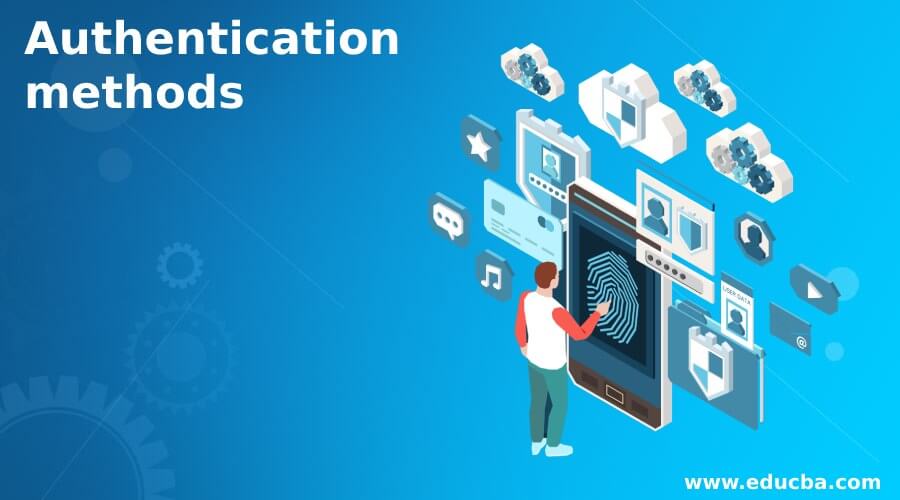Updated August 19, 2023
Introduction to Authentication Methods
Authentication methods are essential to validate the user. This is the first step in any application dealing with user data or any protected resource we want to secure. We can use many ways and types of authentication to secure our resources. We can see this type of security for the user on many social websites and other platforms, ensuring our data is secure from the outside world.
We cannot rely on the password to secure resources; now, we have various types of Authentication methods which can be used, both online and physically, or by authenticating the user via email, SWM, or tokens. Many more forms we have available. In the coming section of the tutorial, we will have a closer look at each Authentication method type available to secure our resources from the outside world.
Advantages of Authentication Methods
- It helps us to validate user access.
- It helps us to secure our data from the outside world.
- We can authenticate online as well as physically.
- We can authenticate users Via OpenID Connect.
Various Authentication Methods
In this section, we will discuss in detail the various Authentication methods for beginners to understand them better, so let’s get started with each of them
1. Multi-factor authentication
First, we will discuss the MFA, Multi-factor authentication, in detail; in this type of authentication, the user is required to authenticate more than once, which means that they can either by smartphone, any token, a captcha, and many more. We can have many Multi-factor authentications in place to authenticate the user. Also, we can use email to authenticate the user. The user’s registered email id is used to send an email, which they must verify. Once the verification process is successful, the user can access the resource. In short, it added multiple layers of security to the user resource, which gives confidence to the user about their data.
Advantage:
- The Authentication mechanism provides a different layer of protection for user data.
Disadvantages:
- Losing the phone may cause issues.
- In such a case, they cannot generate the token or number to authenticate.
2. Password-based authentication
We can use this authenticating process to authenticate the user; this is the most common and less secure because it just updates the user based on their password. The user requires no extra authentication. Password creation using the special character, alpha number, and many. Also, they can be a combination of feet letters, etc. So it is always recommended to use a password that does not include your name, dob, and all ad makes it strong using any combination of the unspecified information. So this is not the best way to protect our data from the outside world. In such cases, people always have the same password for the type of accounts they have online, which may cause a serious problem; people do this to remember the password is very difficult.
Advantages:
- Easy to remember.
- No extra authentication is required to validate the user.
- No need to care about the token.
Disadvantages:
- Password-based authentication is very much less secure.
- There is no sufficient protection for our data from online hacks.
- If the password is simple, hackers can easily guess them by trying all the possible combinations.
3. Biometric authentication
Let’s have a closer look at this type of authentication called ‘Biometric authentication’ As the name suggests; it completely relies on the biological appearance or characteristics of the individual to authenticate them. This authenticating method used by government and private organizations helps them authenticate any user easily. Biometric authentication is further divided into more types.
- Facial expression: In this type, they try to match the different characteristics of the face to allowed access to the individual for the resource. This technology prevents spoofing.
- Fingerprint: As the name suggests it tries to match the different characteristics of the finger to allow access to the protected resource. this is also one of the most secure ways.
- Eye scanner: in this type of authentication method, they try to the scanner the retina and iris reorganization to allow access to the user for the particular resource.
4. Token-based authentication
In this type of authentication, we generate a token for the see to access any resource. Let’s understand how this works; first, we must enter our credentials. After this, it tries to generate a token out of that, which is encrypted. And this token is a long string of random characters. So we can use this token to access a resource that indicates that you have already gained access to this resource and are ready to use it. We do not require to enter our credentials again and again. Once the token expires, generating a new token is necessary to regain access. To generate the new token, the user re-enters their credentials and follows the same process as before.
Advantages:
- It provides access to resources for a long period.
- Do not need to enter the credential again and again.
Conclusion
As we have already seen so many Authentication methods to secure our resources, we can choose any of them according to our needs and based on how much the data is private. All the methods are easy to develop and easily integrated with any of the languages available we have, with good online support for developers.
Recommended Articles
We hope that this EDUCBA information on “Authentication Methods” was beneficial to you. You can view EDUCBA’s recommended articles for more information.


